
A | B | C | D | E | F | G | H | CH | I | J | K | L | M | N | O | P | Q | R | S | T | U | V | W | X | Y | Z | 0 | 1 | 2 | 3 | 4 | 5 | 6 | 7 | 8 | 9
Republic of Zambia | |
|---|---|
| Motto: "One Zambia, One Nation" | |
| Anthem: "Stand and Sing of Zambia, Proud and Free" | |
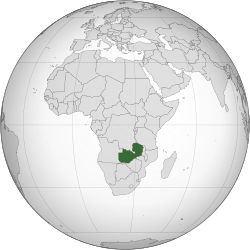 | |
| Capital and largest city | Lusaka 15°25′S 28°17′E / 15.417°S 28.283°E |
| Official languages | English |
| Recognised regional languages | |
| Ethnic groups (2010[1]) | List
|
| Religion | Christianity (official)[2] |
| Demonym(s) | Zambian |
| Government | Unitary presidential republic |
| Hakainde Hichilema | |
| Mutale Nalumango | |
| Legislature | National Assembly |
| Independence from the United Kingdom | |
| 27 June 1890 | |
| 28 November 1899 | |
| 29 January 1900 | |
| 17 August 1911 | |
| 1 August 1953 | |
| 24 October 1964 | |
| 5 January 2016 | |
| Area | |
• Total | 752,617 km2 (290,587 sq mi)[3] (38th) |
• Water (%) | 1 |
| Population | |
• 2023 estimate | 20,216,029[4] (63rd) |
• Density | 17.2/km2 (44.5/sq mi) (191st) |
| GDP (PPP) | 2023 estimate |
• Total | |
• Per capita | |
| GDP (nominal) | 2023 estimate |
• Total | |
• Per capita | |
| Gini (2015) | 57.1[6] high |
| HDI (2019) | medium (146th) |
| Currency | Zambian kwacha (ZMW) |
| Time zone | UTC+2 (CAT) |
| Date format | dd/mm/yyyy |
| Driving side | left |
| Calling code | +260 |
| ISO 3166 code | ZM |
| Internet TLD | .zm |
Zambia,[a] officially the Republic of Zambia,[b] is a landlocked country at the crossroads of Central, Southern and East Africa.[8] It is typically referred to being in South-Central Africa or Southern Africa. It is bordered to the north by the Democratic Republic of the Congo, Tanzania to the north-east, Malawi to the east, Mozambique to the southeast, Zimbabwe and Botswana to the south, Namibia to the southwest, and Angola to the west. The capital city of Zambia is Lusaka, located in the south-central part of Zambia. The population is concentrated mainly around Lusaka in the south and the Copperbelt Province to the north, the core economic hubs of the country.
Originally inhabited by Khoisan peoples, the region was affected by the Bantu expansion of the thirteenth century. Following European explorers in the 18th century, the British colonised the region into the British protectorates of Barotziland–North-Western Rhodesia and North-Eastern Rhodesia towards the end of the 19th century. These were merged in 1911 to form Northern Rhodesia. For most of the colonial period, Zambia was governed by an administration appointed from London with the advice of the British South Africa Company.[9]
On 24 October 1964, Zambia became independent of the United Kingdom and prime minister Kenneth Kaunda became the inaugural president. Kaunda's socialist United National Independence Party (UNIP) maintained power from 1964 until 1991. Kaunda played a key role in regional diplomacy, cooperating closely with the United States in search of solutions to conflicts in Southern Rhodesia (Zimbabwe), Angola, and Namibia.[10] From 1972 to 1991 Zambia was a one-party state with UNIP as the sole legal political party under the motto "One Zambia, One Nation" coined by Kaunda. Kaunda was succeeded by Frederick Chiluba of the social-democratic Movement for Multi-Party Democracy in 1991, beginning a period of socio-economic development and government decentralisation. Zambia has since become a multi-party state and has experienced several peaceful transitions of power.
Zambia contains abundant natural resources, including minerals, wildlife, forestry, freshwater, and arable land.[11] In 2010, the World Bank named Zambia among the top 10 reformers in the World Bank's Ease of doing business index.[12] As of the latest estimate in 2018, 47.9 percent of the population is affected by multidimensional poverty.[13] The Common Market for Eastern and Southern Africa (COMESA) is headquartered in Lusaka.
Name
The territory of Zambia was known as Northern Rhodesia from 1911 to 1964. It was renamed Zambia in October 1964 on its independence from British rule. The name Zambia derives from the Zambezi River (Zambezi may mean "the grand river").[14]
History
Prehistoric era
Archaeological excavation work on the Zambezi Valley and Kalambo Falls shows a succession of human cultures. Ancient camp site tools near the Kalambo Falls have been radiocarbon dated to more than 36,000 years ago.
The fossil skull remains of Broken Hill Man (also known as Kabwe Man), dated between 300,000 and 125,000 years BC, further shows that the area was inhabited by early humans.[15] Broken Hill Man was discovered in Zambia in Kabwe District.
Khoisan and Batwa
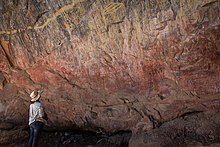
Modern Zambia once was inhabited by the Khoisan and Batwa peoples until around AD 300, when migrating Bantu began to settle the areas.[16] It is believed the Khoisan people originated in East Africa and spread southwards around 150,000 years ago. The Twa people were split into two groups: the Kafwe Twa lived around the Kafue Flats and the Lukanga Twa who lived around the Lukanga Swamp.[17] Many examples of ancient rock art in Zambia, like the Mwela Rock Paintings, Mumbwa Caves, and Nachikufu Cave, are attributed to these early hunter-gatherers.[18]The Khoisan and especially the Twa formed a patron-client relationship with farming Bantu peoples across central and southern Africa but were eventually either displaced by or absorbed into the Bantu groups.
The Bantu (Abantu)
The Bantu people or Abantu (meaning people) are an enormous and diverse ethnolinguistic group that comprise the majority of people in much of eastern, southern and central Africa. Due to Zambia's location at the crossroads of Central Africa, Southern Africa, and the African Great Lakes, the history of the people that constitute modern Zambians is a history of these three regions.
Many of the historical events in these three regions happened simultaneously, and thus Zambia's history, like that of many African nations, cannot be presented perfectly chronologically. The early history of the peoples of modern Zambia is deduced from oral records, archaeology, and written records, mostly from non-Africans.[19]
Bantu origins
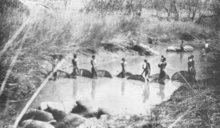
The Bantu people originally lived in West and Central Africa around what is today Cameroon and Nigeria.[20] Around 5000 years ago they began a millennia-long expansion into much of the continent. This event has been called the Bantu expansion;[21] it was one of the largest human migrations in history. The Bantu are believed to have been the first to have brought iron working technology into large parts of Africa. The Bantu Expansion happened primarily through two routes: a western one via the Congo Basin and an eastern one via the African Great Lakes.[22]
First Bantu settlement
The first Bantu people to arrive in Zambia came through the eastern route via the African Great Lakes. They arrived around the first millennium C.E, and among them were the Tonga people (also called Ba-Tonga, "Ba-" meaning "men") and the Ba-Ila and Namwanga and other related groups, who settled around Southern Zambia near Zimbabwe. Ba-Tonga oral records indicate that they came from the east near the "big sea".
They were later joined by the Ba-Tumbuka who settled around Eastern Zambia and Malawi.
These first Bantu people lived in large villages. They lacked an organised unit under a chief or headman and worked as a community and helped each other in times of field preparation for their crops. Villages moved around frequently as the soil became exhausted as a result of the slash-and-burn technique of planting crops. The people also kept large herds of cattle, which formed an important part of their societies.[23]
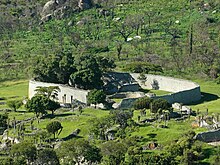
The first Bantu communities in Zambia were highly self-sufficient. Early European missionaries who settled in southern Zambia noted the independence of these Bantu societies. One of these missionaries noted: " weapons for war, hunting, and domestic purposes are needed, the man goes to the hills and digs until he finds the iron ore. He smelts it and with the iron thus obtained makes axes, hoes, and other useful implements. He burns wood and makes charcoal for his forge. His bellows are made from the skins of animals and the pipes are clay tile, and the anvil and hammers are also pieces of the iron he has obtained. He moulds, welds, shapes, and performs all the work of the ordinary blacksmith."[24]
These early Bantu settlers also participated in the trade at the site Ingombe Ilede (which translates to sleeping cow in Chi-Tonga because the fallen baobab tree appears to resemble a cow) in Southern Zambia. At this trading site they met numerous Kalanga/Shona traders from Great Zimbabwe and Swahili traders from the East African Swahili coast. Ingombe Ilede was one of the most important trading posts for rulers of Great Zimbabwe, others being the Swahili port cities like Sofala.
The goods traded at Ingombe Ilede included fabrics, beads, gold, and bangles. Some of these items came from what is today southern Democratic Republic of Congo and Kilwa Kisiwani while others came from as far away as India, China and the Arab world.[25] The African traders were later joined by the Portuguese in the 16th century.[26]
The decline of Great Zimbabwe, due to increasing trade competition from other Kalanga/Shona kingdoms like Khami and Mutapa, spelt the end of Ingombe Ilede.
Second Bantu settlement
The second mass settlement of Bantu people into Zambia was of people groups that are believed to have taken the western route of the Bantu migration through the Congo Basin. These Bantu people spent the majority of their existence in what is today the Democratic Republic of Congo and are ancestors of the majority of modern Zambians.[27]
While there is some evidence that the Bemba people or AbaBemba have a strong ancient connection to the Kongo Kingdom through BaKongo ruler Mwene Kongo VIII Mvemba, this is not well documented.
Luba-Lunda states

The Bemba, along with other related groups like the Lamba, Bisa, Senga, Kaonde, Swaka, Nkoya and Soli, formed integral parts of the Luba Kingdom in Upemba part of the Democratic Republic of Congo and have a strong relation to the BaLuba people. The area which the Luba Kingdom occupied has been inhabited by early farmers and iron workers since the 300s C.E.
Over time these communities learned to use nets and harpoons, make dugout canoes, clear canals through swamps and make dams as high as 2.5 meters (8 ft 2 in). As a result, they grew a diverse economy trading fish, copper and iron items and salt for goods from other parts of Africa, like the Swahili coast and, later on, the Portuguese. From these communities arose the Luba Kingdom in the 14th century.[28]
The Luba Kingdom was a large kingdom with a centralised government and smaller independent chiefdoms. It had large trading networks that linked the forests in the Congo Basin and the mineral-rich plateaus of what is today Copperbelt Province and stretched from the Atlantic coast to the Indian Ocean coast. The arts were also held in high esteem in the kingdom, and artisans were held in high regard.[28]
Literature was well developed in the Luba Kingdom. One renowned Luba genesis story that articulated the distinction between two types of Luba emperors goes as follows:
Nkongolo Mwamba, the red king, and Ilunga Mbidi Kiluwe, a prince of legendary black complexion. Nkongolo Mwamba is the drunken and cruel despot, Ilunga Mbidi Kiluwe the refined and gentle prince. Nkongolo the Red is a man without manners, a man who eats in public, gets drunk, and cannot control himself, whereas Mbidi Kiluwe is a man of reservation, obsessed with good manners; he does not eat in public, controls his language and his behaviour, and keeps a distance from the vices and modus vivendi of ordinary people. Nkongolo Mwamba symbolizes the embodiment of tyranny, whereas Mbidi Kiluwe remains the admired caring and compassionate kin.[29]
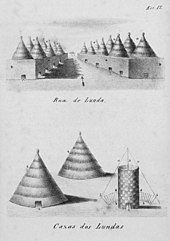
In the same region of Southern Congo the Lunda people were made into a satellite of the Luba empire and adopted forms of Luba culture and governance, thus becoming the Lunda Empire to the south. According to Lunda genesis myths, a Luba hunter named Chibinda Ilunga, son of Ilunga Mbidi Kiluwe, introduced the Luba model of statecraft to the Lunda sometime around 1600 when he married a local Lunda princess named Lueji and was granted control of her kingdom. Most rulers who claimed descent from Luba ancestors were integrated into the Luba empire. The Lunda kings, however, remained separate and actively expanded their political and economic dominance over the region.[28]
The Lunda, like its parent state Luba, also traded with both coasts, the Atlantic and Indian Oceans. While ruler Mwaant Yaav Naweej had established trade routes to the Atlantic coast and initiated direct contact with European traders eager for slaves and forest products and controlling the regional Copper trade, and settlements around Lake Mweru regulated commerce with the East African coast.[28]
The Luba-Lunda states eventually declined as a result of both Atlantic slave trade in the west and Indian Ocean slave trade in the east and wars with breakaway factions of the kingdoms. The Chokwe, a group that is closely related to the Luvale and formed a Lunda satellite state, initially suffered from the European demand for slaves, but once they broke away from the Lunda state, they themselves became notorious slave traders, exporting slaves to both coasts.
The Chokwe eventually were defeated by the other ethnic groups and the Portuguese.[30] This instability caused the collapse of the Luba-Lunda states and a dispersal of people into various parts of Zambia from the Democratic Republic of the Congo. The majority of Zambians trace their ancestry to the Luba-Lunda and surrounding Central African states.[31]
The Maravi Confederacy
In the 1200s, before the founding of the Luba-Lunda states, a group of Bantu people started migrating from the Congo Basin to Lake Mweru then finally settled around Lake Malawi. These migrants are believed to have been one of the inhabitants around the Upemba area in the Democratic Republic of Congo. By the 1400s these groups of migrants collectively called the Maravi, and most prominently among them was the Chewa people (AChewa), who started assimilating other Bantu groups like the Tumbuka.[32]
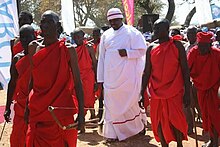
In 1480 the Maravi Empire was founded by the kalonga (paramount chief of the Maravi) from the Phiri clan, one of the main clans, with the others being Banda, Mwale and Nkhoma. The Maravi Empire stretched from the Indian Ocean through what today is Mozambique to Zambia and large parts of Malawi. The political organization of the Maravi resembled that of the Luba and is believed to have originated from there. The primary export of the Maravi was ivory, which was transported to Swahili brokers.[32]
Iron was also manufactured and exported. In the 1590s the Portuguese endeavoured to take monopoly over Maravi export trade. This attempt was met with outrage by the Maravi of Lundu, who unleashed their WaZimba armed force. The WaZimba sacked the Portuguese trade towns of Tete, Sena and various other towns.[33]
The Maravi are also believed to have brought the traditions that would become Nyau secret society from Upemba. The Nyau form the cosmology or indigenous religion of the people of Maravi. The Nyau society consists of ritual dance performances and masks used for the dances; this belief system spread around the region.[34]
The Maravi declined as a result of succession disputes within the confederacy, attack by the Ngoni and slave raids from the Yao.[33]
Mutapa Empire and Mfecane
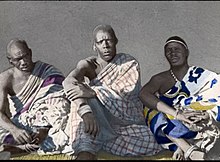
As Great Zimbabwe was in decline, one of its princes, Nyatsimba Mutota, broke away from the state forming a new empire called Mutapa. The title of Mwene Mutapa, meaning "Ravager of the Lands", was bestowed on him and subsequent rulers.[35]
The Mutapa Empire ruled territory between the Zambezi and Limpopo rivers, in what is now Zambia, Zimbabwe and Mozambique, from the 14th to the 17th century. By its, peak Mutapa had conquered the Dande area of the Tonga and Tavara. The Mutapa Empire predominately engaged in the Indian Ocean transcontinental trade with and via the WaSwahili. The primary exported gold and ivory for silk and ceramics from Asia.[36]
Like their contemporaries in Maravi, Mutapa had problems with the arriving Portuguese traders. The peak of this uneasy relationship was reached when the Portuguese attempted to influence the kingdoms internal affairs by establishing markets in the kingdom and converting the population to Christianity. This action caused outrage by the Muslim WaSwahili living in the capital, this chaos gave the Portuguese the excuse they were searching for to warrant an attack on the kingdom and try to control its gold mines and ivory routes. This attack failed when the Portuguese succumbed to disease along the Zambezi river.[37]
In the 1600s internal disputes and civil war began the decline of Mutapa. The weakened kingdom was finally conquered by the Portuguese and was eventually taken over by rival Shona states.[37]
The Portuguese also had vast estates, known as Prazos, and they used slaves and ex-slaves as security guards and hunters. They trained the men in military tactics and gave them guns. These men became expert elephant hunters and were known as the Chikunda. After the decline of the Portuguese the Chikunda made their way to Zambia.[38]

It is hypothesised by Julian Cobbing that the presence of early Europeans slave trading and attempts to control resources in various parts of Bantu-speaking Africa caused the gradual militarization of the people in the region. This can be observed with the Maravi's WaZimba warrior caste, who, once defeating the Portuguese, remained quite militaristic afterwards.
The Portuguese presence in the region was also a major reason for the founding of the Rozvi Empire, a breakaway state of Mutapa. The ruler of the Rozvi, Changamire Dombo, became one of the most powerful leaders in South-Central Africa's history. Under his leadership, the Rozvi defeated the Portuguese and expelled them from their trading posts along the Zambezi river.[39]
But perhaps the most notable instance of this increased militarization was the rise of the Zulu under the leadership of Shaka. Pressures from the English colonialists in the Cape and increased militarization of the Zulu resulted in the Mfecane (the crushing). The Zulu expanded by assimilating the women and children of tribes they defeated, if the men of these Nguni tribes escaped slaughter, they used the military tactics of the Zulu to attack other groups.[40]
This caused mass displacements, wars and raids throughout Southern, Central and Eastern Africa as Nguni or Ngoni tribes made their way throughout the region and is referred to as the Mfecane. The arriving Nguni under the leadership of Zwagendaba crossed the Zambezi river moving northwards. The Ngoni were the final blow to the already weakened Maravi Empire. Many Nguni eventually settled around what is today Zambia, Malawi, Mozambique and Tanzania and assimilated into neighbouring tribes.[40]
In the western part of Zambia, another Southern African group of Sotho-Tswana heritage called the Kololo manage to conquer the local inhabitants who were migrants from the fallen Luba and Lunda states called the Luyana or Aluyi. The Luyana established the Barotse Kingdom on the floodplains of the Zambezi upon their arrival from Katanga. Under the Kololo, the Kololo language was imposed upon the Luyana until the Luyana revolted and overthrew the Kololo by this time the Luyana language was largely forgotten and a new hybrid language emerged, SiLozi and the Luyana began to refer to themselves as Lozi.[41]
At the end of the 18th century, some of the Mbunda migrated to Barotseland, Mongu upon the migration of among others, the Ciyengele.[42][43] The Aluyi and their leader, the Litunga Mulambwa, especially valued the Mbunda for their fighting ability.
By the late 18th century, most of the various peoples of Zambia were established in their current areas.
Colonial Period
Europeans

One of the earliest recorded Europeans to visit the area was the Portuguese explorer Francisco de Lacerda in the late 18th century. Lacerda led an expedition from Mozambique to the Kazembe region in Zambia (with the goal of exploring and to crossing Southern Africa from coast to coast for the first time),[44] and died during the expedition in 1798. The expedition was from then on led by his friend Francisco Pinto.[45] This territory, located between Portuguese Mozambique and Portuguese Angola, was claimed and explored by Portugal in that period.
Other European visitors followed in the 19th century. The most prominent of these was David Livingstone, who had a vision of ending the slave trade through the "3 Cs": Christianity, Commerce, and Civilisation. He was the first European to see the magnificent waterfalls on the Zambezi River in 1855, naming them the Victoria Falls after Queen Victoria of the United Kingdom. He described them thus: "Scenes so lovely must have been gazed upon by angels in their flight".[46]
Locally the falls are known as "Mosi-o-Tunya" or "thundering smoke" in the Lozi or Kololo dialect. The town of Livingstone, near the Falls, is named after him. Highly publicised accounts of his journeys motivated a wave of European visitors, missionaries and traders after his death in 1873.[47]
British South Africa Company
In 1888, the British South Africa Company (BSA Company), led by Cecil Rhodes, obtained mineral rights from the Litunga of the Lozi people, the Paramount Chief of the Lozi (Ba-rotse) for the area which later became Barotziland-North-Western Rhodesia.[48]
To the east, in December 1897 a group of the Angoni or Ngoni (originally from Zululand) rebelled under Tsinco, son of King Mpezeni, but the rebellion was put down,[49] and Mpezeni accepted the Pax Britannica. That part of the country then came to be known as North-Eastern Rhodesia. In 1895, Rhodes asked his American scout Frederick Russell Burnham to look for minerals and ways to improve river navigation in the region, and it was during this trek that Burnham discovered major copper deposits along the Kafue River.[50]
North-Eastern Rhodesia and Barotziland-North-Western Rhodesia were administered as separate units until 1911 when they were merged to form Northern Rhodesia, a British protectorate. In 1923, the BSA Company ceded control of Northern Rhodesia to the British Government after the government decided not to renew the company's charter.
British colonisation
In 1923, Southern Rhodesia (now Zimbabwe), a conquered territory which was also administered by the BSA Company, became a self-governing British colony. In 1924, after negotiations, the administration of Northern Rhodesia transferred to the British Colonial Office.
- Federation of Rhodesia and Nyasaland
In 1953, the creation of the Federation of Rhodesia and Nyasaland grouped together Northern Rhodesia, Southern Rhodesia, and Nyasaland (now Malawi) as a single semi-autonomous region. This was undertaken despite opposition from a sizeable minority of the population, who demonstrated against it in 1960–61.[51] Northern Rhodesia was the center of much of the turmoil and crisis characterizing the federation in its last years. Initially, Harry Nkumbula's African National Congress (ANC) led the campaign, which Kenneth Kaunda's United National Independence Party (UNIP) subsequently took up.
Independence
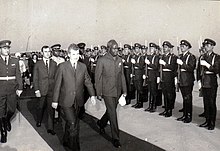
A two-stage election held in October and December 1962 resulted in an African majority in the legislative council and an uneasy coalition between the two African nationalist parties. The council passed resolutions calling for Northern Rhodesia's secession from the federation and demanding full internal self-government under a new constitution and a new National Assembly based on a broader, more democratic franchise.[citation needed]
The federation was dissolved on 31 December 1963, and in January 1964, Kaunda won the only election for Prime Minister of Northern Rhodesia. The Colonial Governor, Sir Evelyn Hone, was very close to Kaunda and urged him to stand for the post. Soon after, there was an uprising in the north of the country known as the Lumpa Uprising led by Alice Lenshina – Kaunda's first internal conflict as leader of the nation.[52]
Northern Rhodesia became the Republic of Zambia on 24 October 1964, with Kenneth Kaunda as the first president. At independence, despite its considerable mineral wealth, Zambia faced major challenges. Domestically, there were few trained and educated Zambians capable of running the government, and the economy was largely dependent on foreign expertise. This expertise was provided in part by John Willson CMG[53] There were over 70,000 Europeans resident in Zambia in 1964, and they remained of disproportionate economic significance.[54]
Post Independence
Kaunda's endorsement of Patriotic Front guerrillas conducting raids into neighbouring (Southern) Rhodesia resulted in political tension and a militarisation of the border, leading to its closure in 1973.[55] The Kariba hydroelectric station on the Zambezi River provided sufficient capacity to satisfy the country's requirements for electricity, despite Rhodesian management.

On 3 September 1978, civilian airliner, Air Rhodesia Flight 825, was shot down near Kariba by the Zimbabwe People's Revolutionary Army (ZIPRA). 18 people, including children, survived the crash only for most of them to be shot by militants of the Zimbabwe African People's Union (ZAPU) led by Joshua Nkomo. Rhodesia responded with Operation Gatling, an attack on Nkomo's guerilla bases in Zambia, in particular, his military headquarters just outside Lusaka; this raid became known as the Green Leader Raid. On the same day, two more bases in Zambia were attacked using air power and elite paratroops and helicopter-borne troops.[56]
A railway (TAZARA – Tanzania Zambia Railways) to the Tanzanian port of Dar es Salaam, completed in 1975 with Chinese assistance, reduced Zambian dependence on railway lines south to South Africa and west through an increasingly troubled Portuguese Angola. Until the completion of the railway, Zambia's major artery for imports and the critical export of copper was along the TanZam Road, running from Zambia to the port cities in Tanzania. The Tazama oil pipeline was also built from Dar es Salaam to Ndola in Zambia.
By the late 1970s, Mozambique and Angola had attained independence from Portugal. Rhodesia's predominantly white government, which issued a Unilateral Declaration of Independence in 1965, accepted majority rule under the Lancaster House Agreement in 1979.[57]
Civil strife in both Portuguese colonies and a mounting Namibian War of Independence resulted in an influx of refugees[58] and compounded transportation issues. The Benguela railway, which extended west through Angola, was essentially closed to Zambian traffic by the late 1970s. Zambia's support for anti-apartheid movements such as the African National Congress (ANC) also created security problems as the South African Defence Force struck at dissident targets during external raids.[59]
In 1989, two of Zambia's natural sites, Mosi-oa-Tunya National Park and Victoria Falls were inscribed on the UNESCO World Heritage List.
Economic troubles
In the mid-1970s, the price of copper, Zambia's principal export, suffered a severe decline worldwide. In Zambia's situation, the cost of transporting the copper great distances to the market was an additional strain. Zambia turned to foreign and international lenders for relief, but, as copper prices remained depressed, it became increasingly difficult to service its growing debt. By the mid-1990s, despite limited debt relief, Zambia's per capita foreign debt remained among the highest in the world.[60]
Democratisation
In June 1990 riots against Kaunda accelerated. Many protesters were killed by the regime in breakthrough June 1990 protests.[61][62] In 1990 Kaunda survived an attempted coup, and in 1991 he agreed to reinstate multiparty democracy, having instituted one-party rule under the Choma Commission of 1972. Following multiparty elections, Kaunda was removed from office (see below).
In the 2000s, the economy stabilised, attaining single-digit inflation in 2006–2007, real GDP growth, decreasing interest rates, and increasing levels of trade. Much of its growth is due to foreign investment in mining and to higher world copper prices. All this led to Zambia being courted enthusiastically by aid donors and saw a surge in investor confidence in the country.
Politics

Politics in Zambia takes place in a framework of a presidential representative democratic republic, whereby the President of Zambia is both head of state and head of government in a pluriform multi-party system. The government exercises executive power, while legislative power is vested in both the government and parliament.
Zambia became a republic immediately upon attaining independence in October 1964. From 2011 to 2014, Zambia's president had been Michael Sata, until Sata died on 28 October 2014.[63] After Sata's death, Vice President Guy Scott, a Zambian of Scottish descent, became acting President of Zambia. Presidential elections were held on 22 January 2015. A total number of 11 presidential candidates contested in the election and On 24 January 2015, it was announced that Edgar Chagwa Lungu had won the election to become the 6th President in a tightly contested race. He won 48.33% of the vote, a lead of 1.66% over his closest rival, Hakainde Hichilema, with 46.67%.[64] Nine other candidates all got less than 1% each. In August 2016 Zambian general election president Edgar Lungu won re-election narrowly in the first round of the election. The opposition had allegations of fraud and the governing Patriotic Front (PF) rejected the allegations made by opposition UPND party.[65]
In the 2021 general elections, characterised by a 70% voter turnout, Hakainde Hichilema won 59% of the vote, with his closest rival, incumbent president Edgar Chagwa Lungu, receiving 39% of the vote.[66] On 16 August Edgar Lungu conceded in a TV statement, sending a letter and congratulating president-elect Hakainde Hichilema.[67][68] On 24 August 2021, Hakainde Hichilema was sworn in as the new President of Zambia.[69]
Foreign relations

After independence in 1964, the foreign relations of Zambia were mostly focused on supporting liberation movements in other countries in Southern Africa, such as the African National Congress and SWAPO. During the Cold War, Zambia was a member of the Non-Aligned Movement.
Military
The Zambian Defence Force (ZDF) consists of the Zambia Army (ZA), the Zambia Air Force (ZAF), and the Zambian National Service (ZNS). The ZDF is designed primarily against external threats.
In 2019, Zambia signed the UN treaty on the Prohibition of Nuclear Weapons.[70]
Administrative divisionsedit

Zambia is administratively divided into ten provinces subdivided into 117 districts, and electorally into 156 constituencies and 1,281 wards.
- Provinces
- Central Province
- Copperbelt
- Eastern Province
- Luapula
- Lusaka
- Muchinga
- North-Western Province
- Northern Province
- Southern Province
- Western Province
Human rightsedit
The government is sensitive to any opposition and criticism and has been quick to prosecute critics using the legal pretext that they had incited public disorder. Libel laws are used to suppress free speech and the press.[71]
Same-sex sexual activity is illegal for both males and females in Zambia.[72][73] A 2010 survey revealed that only 2% of Zambians find homosexuality to be morally acceptable.[74]
In December 2019, it was reported that United States Ambassador to Zambia Daniel Lewis Foote was "horrified" by Zambia's jailing of same-sex couple Japhet Chataba and Steven Samba. After an appeal failed and the couple was sentenced to 15 years in prison, Foote asked the Zambian government to review both the case and the country's anti-homosexuality laws. Foote faced a backlash and canceled public appearances after he was threatened on social media, and was subsequently recalled after President Lungu declared him persona non grata.[75]
Geographyedit
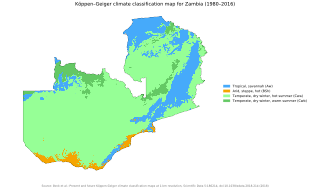
Zambia is a landlocked country in southern Africa, with a tropical climate, and consists mostly of high plateaus with some hills and mountains, dissected by river valleys. At 752,614 km2 (290,586 sq mi) it is the 39th-largest country in the world, slightly smaller than Chile. The country lies mostly between latitudes 8° and 18°S, and longitudes 22° and 34°E.
Zambia is drained by two major river basins: the Zambezi/Kafue basin in the center, west, and south covering about three-quarters of the country; and the Congo basin in the north covering about one-quarter of the country. A very small area in the northeast forms part of the internal drainage basin of Lake Rukwa in Tanzania.
In the Zambezi basin, there are a number of major rivers flowing wholly or partially through Zambia: the Kabompo, Lungwebungu, Kafue, Luangwa, and the Zambezi itself, which flows through the country in the west and then forms its southern border with Namibia, Botswana and Zimbabwe. Its source is in Zambia but it diverts into Angola, and a number of its tributaries rise in Angola's central highlands. The edge of the Cuando River floodplain (not its main channel) forms Zambia's southwestern border, and via the Chobe River that river contributes very little water to the Zambezi because most are lost by evaporation.[76]
Two of the Zambezi's longest and largest tributaries, the Kafue and the Luangwa, flow mainly in Zambia. Their confluences with the Zambezi are on the border with Zimbabwe at Chirundu and Luangwa town respectively. Before its confluence, the Luangwa River forms part of Zambia's border with Mozambique. From Luangwa town, the Zambezi leaves Zambia and flows into Mozambique, and eventually into the Mozambique Channel.
The Zambezi falls about 100 metres (328 ft) over the 1.6-kilometre-wide (1-mile) Victoria Falls, located in the southwest corner of the country, subsequently flowing into Lake Kariba. The Zambezi valley, running along the southern border, is both deep and wide. From Lake Kariba going east, it is formed by grabens and like the Luangwa, Mweru-Luapula, Mweru-wa-Ntipa and Lake Tanganyika valleys, is a rift valley.
The north of Zambia is very flat with broad plains. In the west the most notable being the Barotse Floodplain on the Zambezi, which floods from December to June, lagging behind the annual rainy season (typically November to April). The flood dominates the natural environment and the lives, society, and culture of the inhabitants and those of other smaller, floodplains throughout the country.

In Eastern Zambia the plateau which extends between the Zambezi and Lake Tanganyika valleys is tilted upwards to the north, and so rises imperceptibly from about 900 m (2,953 ft) in the south to 1,200 m (3,937 ft) in the centre, reaching 1,800 m (5,906 ft) in the north near Mbala. These plateau areas of northern Zambia have been categorised by the World Wildlife Fund as a large section of the Central Zambezian miombo woodlands ecoregion.[77]
Eastern Zambia shows great diversity. The Luangwa Valley splits the plateau in a curve north-east to south-west, extended west into the heart of the plateau by the deep valley of the Lunsemfwa River. Hills and mountains are found by the side of some sections of the valley, notably in its north-east the Nyika Plateau (2,200 m or 7,218 ft) on the Malawi border, which extend into Zambia as the Mafinga Hills, containing the country's highest point, Mafinga Central (2,339 m or 7,674 ft).[78]
The Muchinga Mountains, the watershed between the Zambezi and Congo drainage basins, run parallel to the deep valley of the Luangwa River and form a sharp backdrop to its northern edge, although they are almost everywhere below 1,700 m (5,577 ft). Their culminating peak Mumpu is at the western end and at 1,892 m (6,207 ft) is the highest point in Zambia away from the eastern border region. The border of the Congo Pedicle was drawn around this mountain.
The southernmost headstream of the Congo River rises in Zambia and flows west through its northern area firstly as the Chambeshi and then, after the Bangweulu Swamps as the Luapula, which forms part of the border with the Democratic Republic of the Congo. The Luapula flows south then west before it turns north until it enters Lake Mweru. The lake's other major tributary is the Kalungwishi River, which flows into it from the east. The Luvua River drains Lake Mweru, flowing out of the northern end to the Lualaba River (Upper Congo River).
Lake Tanganyika is the other major hydrographic feature that belongs to the Congo basin. Its south-eastern end receives water from the Kalambo River, which forms part of Zambia's border with Tanzania. This river has Africa's second highest uninterrupted waterfall, the Kalambo Falls.
Climateedit
Zambia is located on the plateau of Central Africa, between 1,000 and 1,600 metres (3,300 and 5,200 ft) above sea level. The average elevation of 1,200 metres (3,900 ft) gives the land a generally moderate climate. The climate of Zambia is tropical, modified by elevation. In the Köppen climate classification, most of the country is classified as humid subtropical or tropical wet and dry, with small stretches of semi-arid steppe climate in the south-west and along the Zambezi valley.
There are two main seasons, the rainy season (November to April) corresponding to summer, and the dry season (May/June to October/November), corresponding to winter. The dry season is subdivided into the cool dry season (May/June to August), and the hot dry season (September to October/November). The modifying influence of altitude gives the country pleasant subtropical weather rather than tropical conditions during the cool season of May to August.[79] However, average monthly temperatures remain above 20 °C (68 °F) over most of the country for eight or more months of the year.
Biodiversityedit

There are numerous ecosystems in Zambia, such as forest, thicket, woodland and grassland vegetation types.
Zambia has approximately 12,505 identified species – 63% animal species, 33% plant species and 4% bacterial species and other microorganisms.[citation needed]
There are an estimated 3,543 species of wild flowering plants, consisting of sedges, herbaceous plants and woody plants.[80] The Northern and North-Western provinces of the country especially have the highest diversity of flowering plants. Approximately 53% of flowering plants are rare and occur throughout the country.[81]
A total of 242 mammal species are found in the country, with most occupying the woodland and grassland ecosystems. The Rhodesian giraffe and Kafue lechwe are some of the well-known subspecies that are endemic to Zambia.[82]
An estimated 757 bird species have been seen in the country, of which 600 are either resident or Afrotropic migrants; 470 breed in the country; and 100 are non-breeding migrants. The Zambian barbet is a species endemic to Zambia.
Roughly 490 known fish species, belonging to 24 fish families, have been reported in Zambia, with Lake Tanganyika having the highest number of endemic species.[83]
The country had a 2019 Forest Landscape Integrity Index mean score of 7.5/10, ranking it 39th globally out of 172 countries.[84]
Demographicsedit
|
| |||||||||||||||||||||||||||||||||||||||||||||
| Note: In censuses carried out during the British colonial administration prior to 1963, the black African population was estimated rather than counted. Source: Central Statistical Office, Zambia | ||||||||||||||||||||||||||||||||||||||||||||||
As of the 2022 Zambian census, Zambia's population was 19,610,769.[85] Zambia is racially and ethnically diverse, with 73 distinct ethnic groups. During its colonial administration by the British between 1911 and 1963, the country attracted immigrants from Europe and the Indian subcontinent, the latter of whom came as indentured workers. While most Europeans left after the collapse of white-minority rule, many Asians remained. Zambia is home to a growing Asian community, with a majority being of Indian and Chinese descent.

In the first census—conducted on 7 May 1911—there were a total of 1,497 Europeans; 39 Asiatics and an estimated 820,000 black Africans. Black Africans were not counted in the six censuses conducted in 1911, 1921, 1931, 1946, 1951 and 1956, prior to independence, but their population was estimated. By 1956, there were 65,277 Europeans, 5,450 Asiatics, 5,450 coloureds and an estimated 2,100,000 black Africans.
The main ethnic groups in Zambia are Bemba 3.3 million (33.6%), Nyanja 1.8 million (18.2%), Tonga 1.7 million (16.8%), North-Western peoples 1 million (10.3%), Lozi (Barotse) 770,000 (7.8%), Mambwe 580,000 (5.9%), Tumbuka 500,000 (5.1%), Lamba 165,000 (2%), Asians 11,900 and Europeans 6,200.[86]
In the 2010 population census, 99.2% were black Africans and 0.8% consisted of other racial groups.
Graphs are unavailable due to technical issues. There is more info on Phabricator and on MediaWiki.org. |
Zambia is one of the most highly urbanised countries in sub-Saharan Africa, with 44% of the population concentrated along the major transport corridors, while rural areas are sparsely populated. The fertility rate was 6.2 as of 2007[update] (6.1 in 1996, 5.9 in 2001–02).[87]
Largest townsedit
The onset of industrial copper mining on the Copperbelt in the late 1920s triggered rapid urbanisation. Although urbanisation was overestimated during the colonial period, it was substantial.[88] Mining townships on the Copperbelt soon dwarfed existing centres of population and continued to grow rapidly following Zambian independence. Economic decline in the Copperbelt from the 1970s to the 1990s has altered patterns of urban development, but the country's population remains concentrated around the railway and roads running south from the Copperbelt through Kapiri Mposhi, Lusaka, Choma and Livingstone.






